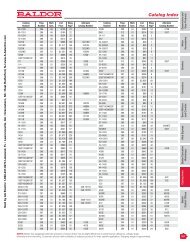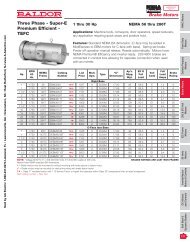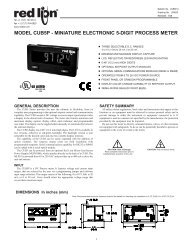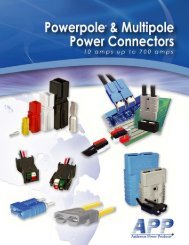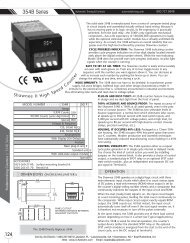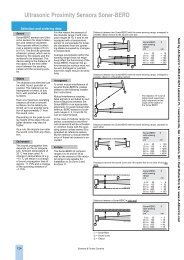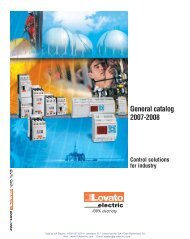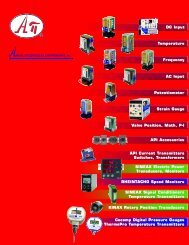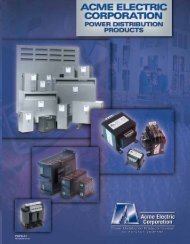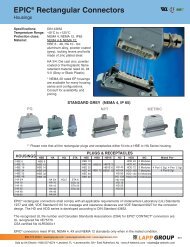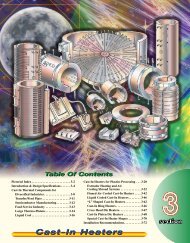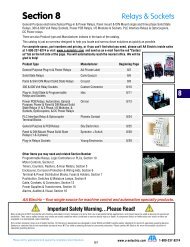G - AA Electric
G - AA Electric
G - AA Electric
You also want an ePaper? Increase the reach of your titles
YUMPU automatically turns print PDFs into web optimized ePapers that Google loves.
Relay coupler – overview<br />
Contact types Protective circuits for the contacts Switching small and large capacities<br />
Sold by <strong>AA</strong> <strong>Electric</strong> 1-800-237-8274 Lakeland, FL • Lawrenceville, GA • Greensboro, NC • East Rutherford, NJ www.A-Aelectric.com<br />
Several contact types and combinations<br />
are available ex stock:<br />
1 NCC (EGR EG7, RS 30)<br />
1 NOC (EGR RG7, DKR, RS 30)<br />
1 NCC and<br />
1 NOC (WRS)<br />
2 NOCs (WRS)<br />
3 NOCs (WRS)<br />
1 change-over contact<br />
(EGR/RST EG7, WRS,<br />
DKR, PRS/PRZ MCZ R,<br />
RS 30, RS 31)<br />
2 change-over contacts<br />
(WRS, RS 32, PRS/PRZ)<br />
4/8/16 change-over contacts<br />
(RSM)<br />
Contact material<br />
The relay modules are suitable for universal<br />
use, with the choice of contact material<br />
the crucial criterion. The contact is<br />
used for safe transmission of control signals<br />
and also for switching power contactors.<br />
Gold-plated or gold-flashed AgNi contacts<br />
are used for most applications. Hard<br />
gold plated contacts with gold plating<br />
exceeding 2 µm in thickness allow even<br />
extremely small capacities (up to 40 µW)<br />
to be switched. AgSnO2 or AgCdO contacts<br />
are used for switching higher capacities<br />
(RS 31).<br />
The switching of inductive or capacitive<br />
loads produces switching sparks which<br />
can influence the electrical service life of<br />
the relays.<br />
The following protective circuits for the<br />
contacts reduce contact wear:<br />
Diode<br />
–<br />
Diode and Z-diode<br />
–<br />
RC combination<br />
–<br />
(~)<br />
Varistor<br />
+<br />
Load<br />
Advantage:<br />
Disadvantage:<br />
–<br />
(~)<br />
+<br />
Load<br />
+<br />
(~)<br />
Load<br />
+<br />
(~)<br />
Load<br />
R<br />
C<br />
VDR<br />
U D<br />
U ZD<br />
U RC<br />
U VDR<br />
U S<br />
1 2 t<br />
Can be used for all capacities,<br />
low overvoltage, minimum<br />
space required, low price<br />
Very large release delay<br />
U S<br />
1 2 t<br />
Advantage: Low overvoltage (defined by<br />
Z-diode), low release delay<br />
Disadvantage: Cannot be used for large<br />
capacities<br />
U S<br />
1 2 t<br />
Advantage: Low overvoltage, low release<br />
delay<br />
Disadvantage: High current load on the contacts<br />
when switching on;<br />
more complicated and expensive<br />
at greater capacities<br />
Advantage:<br />
Disadvantage:<br />
U S Voltage progression<br />
1 Closing<br />
2 Opening<br />
U S<br />
1 2 t<br />
Low release delay, low price<br />
Cannot be used for all operating<br />
voltages and capacities<br />
For automation technology, the EGR EG7<br />
relay coupler is ideal for switching<br />
extremely small capacities (up to 40 µw)<br />
under ohmic load. The signals are reliably<br />
transmitted to the controllers. The switching<br />
of large capacities for energy and<br />
supply technology is achieved by the<br />
RS31 relay coupler, with a guaranteed<br />
switching capacity of 3.5 kVA under<br />
ohmic load.<br />
Switching times of the relay modules<br />
Typical pick-up delay < 10 ms<br />
Typical release delay < 12 ms<br />
Contact service life under ohmic load<br />
DC load-limit curve under ohmic load<br />
Reduction factor F<br />
Number of operations<br />
Direct current (A)<br />
Single contact<br />
Switching capacity (kVA)<br />
Direct voltage (V)<br />
Power factor (cos )<br />
Reduction factor under inductive load<br />
cos ¥ < 1<br />
No. of cycles eff. = No. of cycles at (cos ¥ = 1)<br />
x red. factor F<br />
Relay coupler<br />
K<br />
K.3



